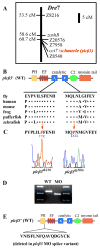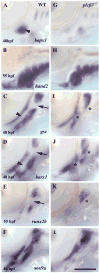phospholipase C, beta 3 is required for Endothelin1 regulation of pharyngeal arch patterning in zebrafish
- PMID: 17239364
- PMCID: PMC1906931
- DOI: 10.1016/j.ydbio.2006.12.027
phospholipase C, beta 3 is required for Endothelin1 regulation of pharyngeal arch patterning in zebrafish
Abstract
Genetic and pharmacological studies demonstrate that Endothelin1 (Edn1) is a key signaling molecule for patterning the facial skeleton in fish, chicks, and mice. When Edn1 function is reduced early in development the ventral lower jaw and supporting structures are reduced in size and often fused to their dorsal upper jaw counterparts. We show that schmerle (she) encodes a zebrafish ortholog of Phospholipase C, beta 3 (Plcbeta3) required in cranial neural crest cells for Edn1 regulation of pharyngeal arch patterning. Sequencing and co-segregation demonstrates that two independent she (plcbeta3) alleles have missense mutations in conserved residues within the catalytic domains of Plcbeta3. Homozygous plcbeta3 mutants are phenotypically similar to edn1 mutants and exhibit a strong arch expression defect in Edn1-dependent Distalless (Dlx) genes as well as expression defects in several Edn1-dependent intermediate and ventral arch domain transcription factors. plcbeta3 also genetically interacts with edn1, supporting a model in which Edn1 signals through a G protein-coupled receptor to activate Plcbeta3. Mild skeletal defects occur in plcbeta3 heterozygotes, showing the plcbeta3 mutations are partially dominant. Through a morpholino-mediated deletion in the N-terminal PH domain of Plcbeta3, we observe a partial rescue of facial skeletal defects in homozygous plcbeta3 mutants, supporting a hypothesis that an intact PH domain is necessary for the partial dominance we observe. In addition, through mosaic analyses, we show that wild-type neural crest cells can efficiently rescue facial skeletal defects in homozygous plcbeta3 mutants, demonstrating that Plcbeta3 function is required in neural crest cells and not other cell types to pattern the facial skeleton.
Figures









References
-
- Appel B, Korzh V, Glasgow E, Thor S, Edlund T, Dawid IB, Eisen JS. Motoneuron fate specification revealed by patterned LIM homeobox gene expression in embryonic zebrafish. Development. 1995;121:4117–25. - PubMed
-
- Clouthier DE, Hosoda K, Richardson JA, Williams SC, Yanagisawa H, Kuwaki T, Kumada M, Hammer RE, Yanagisawa M. Cranial and cardiac neural crest defects in endothelin-A receptor-deficient mice. Development. 1998;125:813–24. - PubMed
-
- Clouthier DE, Williams SC, Hammer RE, Richardson JA, Yanagisawa M. Cell-autonomous and nonautonomous actions of endothelin-A receptor signaling in craniofacial and cardiovascular development. Dev Biol. 2003;261:506–19. - PubMed
-
- Clouthier DE, Williams SC, Yanagisawa H, Wieduwilt M, Richardson JA, Yanagisawa M. Signaling pathways crucial for craniofacial development revealed by endothelin-A receptor-deficient mice. Dev Biol. 2000;217:10–24. - PubMed
Publication types
MeSH terms
Substances
Associated data
- Actions
Grants and funding
LinkOut - more resources
Full Text Sources
Other Literature Sources
Molecular Biology Databases

